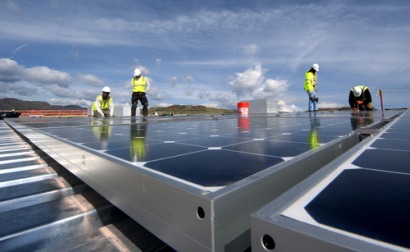
The survey, was conducted by Santa Clara, California-based PV manufacturer Applied Materials in China, India, Japan and the US. Based on its findings, the company concluded that the greatest challenge confronting the industry today is a lack of consumer awareness about the technology.
"Solar power makes sense for our planet and for our children, and we need to recognize that the solution to our energy needs is already in our hands," said Dr. Charlie Gay, president of Applied Materials' Solar division. "By 2050 the world population is expected to plateau at nine billion people, and by that time it will be imperative we have a sustainable energy source in place that has the potential to solve our energy challenges for perpetuity. Since the planning horizon for utilities extends over time periods of 30 to 40 years, the opportunity to influence the world's long-term energy supply is now."
Last year at this time, industry data suggested that by 2020, 98 percent of the world's population would have achieved grid parity, or solar energy power that is cost-competitive with traditional energy prices, but data now suggests this milestone will be achieved by the end of 2012.
Fifty-five percent of all respondents recognize this shift and believe solar energy is less expensive than traditional energy sources, such as coal. Respondents in India were most likely (68%) to believe solar power was less expensive. Conversely, respondents in Japan were most likely (51%) to believe solar power was more expensive compared to traditional energy sources. Of the 35 percent of international consumers who believe solar power to be more expensive, 39 percent believe it will become equal to or less expensive than traditional power within nine years.
"Solar panels now cost less than $1 per watt, which means more than 100 countries have achieved grid parity," Gay said. "We have witnessed an explosion in global solar PV installations in the past year due to the dramatic and accelerated rate of cost reductions in the supply chain. This has resulted in significant decreases in end-market costs, and a continued focus on technology innovation will further drive down the total cost of solar electric power plants."
Global Optimism for Solar Job Opportunities
Nearly half (46%) of all respondents believe the growth of the solar market would create jobs. The United States is most optimistic with nearly six in 10 consumers (58%) expressing this view. China and India are nearly equal in second place in their estimation of job growth, at 49 and 48 percent respectively. Consumers in Japan are the most cautious, with four in 10 believing that it will have no impact on the job market. Twenty-five percent of people surveyed internationally think that it will reduce the number of jobs.
"More than fifty percent of the jobs in the global solar power industry are found after the solar panel leaves the factory, such as construction teams, installers, sales people, designers, engineers, electricians, etc.," said Cathy Boone, senior director for Energy Policy and Market Development at Applied Materials. "Any country, city or community has the potential to directly benefit from the growth in the solar power industry with on-the-ground jobs if they are willing to make a commitment to replacing fossil fuels with solar."
Consumers in India and China Want to Accelerate Solar Adoption
Nearly six in 10 (58%) consumers in China believe that the projected rate of solar energy adoption to15 GW by 2015 is too slow of an adoption rate. And when respondents in India were asked about the government's Ministry of New and Renewable Energy's goal of increasing the contribution of renewable energy to six percent of India's total energy mix by 2022, more than half (51%) voiced concern that the rate of adoption was too slow.
As both countries face rapidly rising energy needs due to a growing population with increasing energy demand, people are realizing that solar power can play a major role in supplying much needed energy and jobs, while simultaneously reducing greenhouse gas emissions.
Solar Education Still Needed
Respondents were most likely to believe the United States (26%) followed by Japan (22%) had installed the greatest number of solar panels, while only 17 percent correctly identified Germany as the leader in solar panel installations. Japanese consumers were far more likely (35%) to correctly identify Germany as the leader compared to respondents from other countries (U.S. 9%; China 15%; India 9%). The top countries in order of cumulative solar installations as of 2011 are Germany, Italy, Japan, Spain, the U.S. and China.
For additional information:

